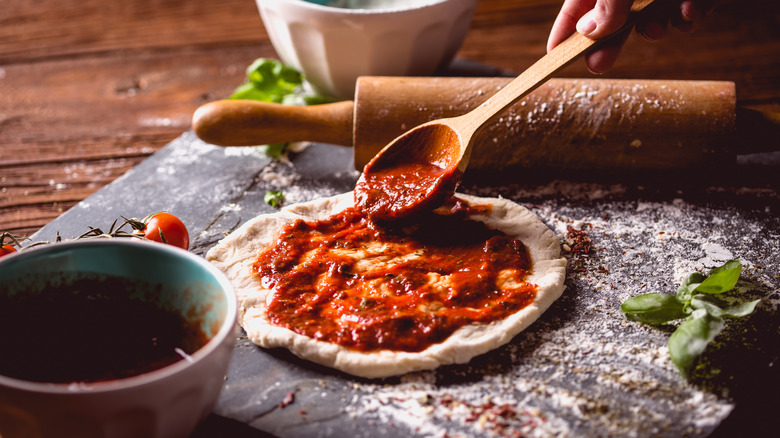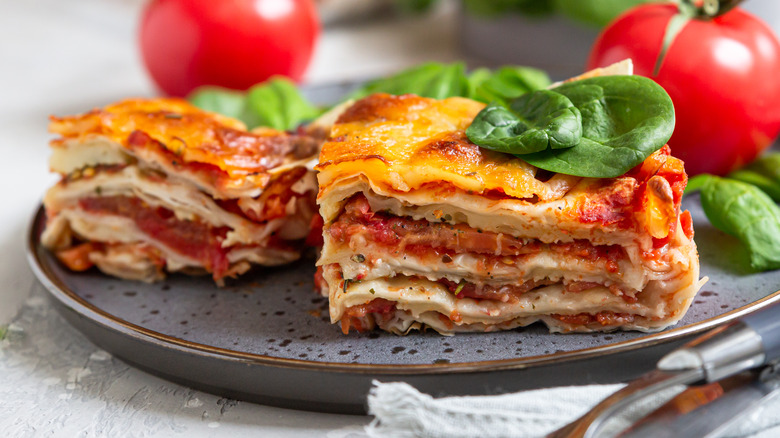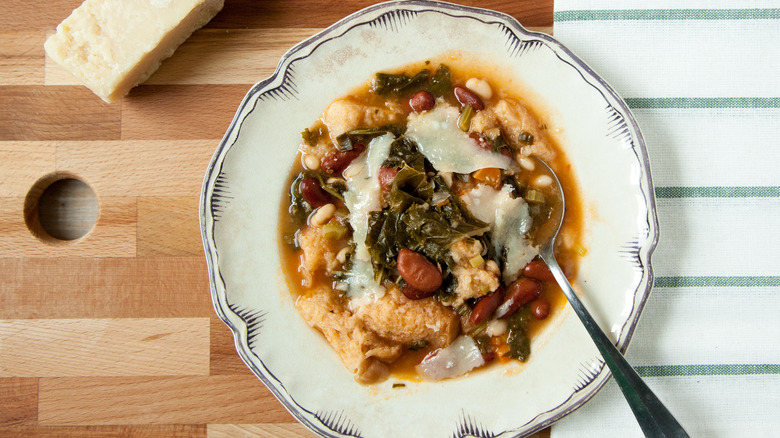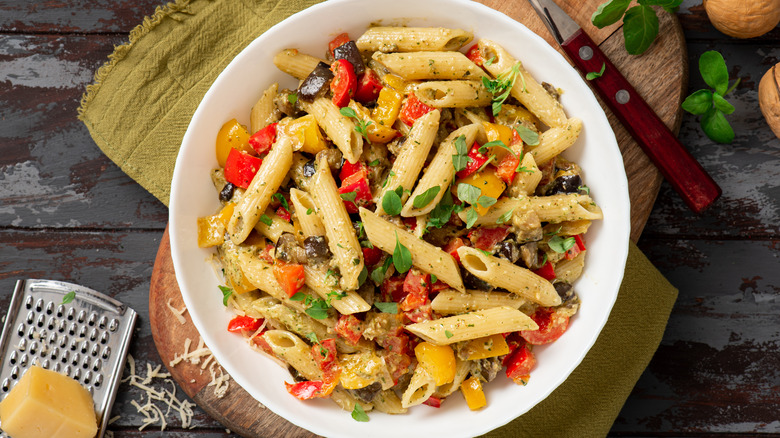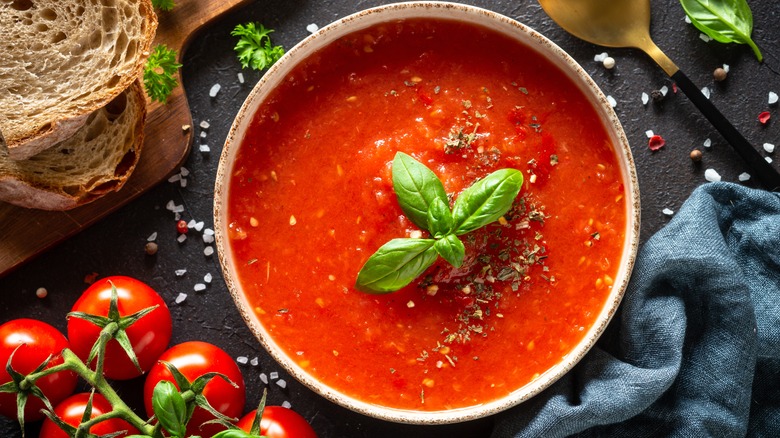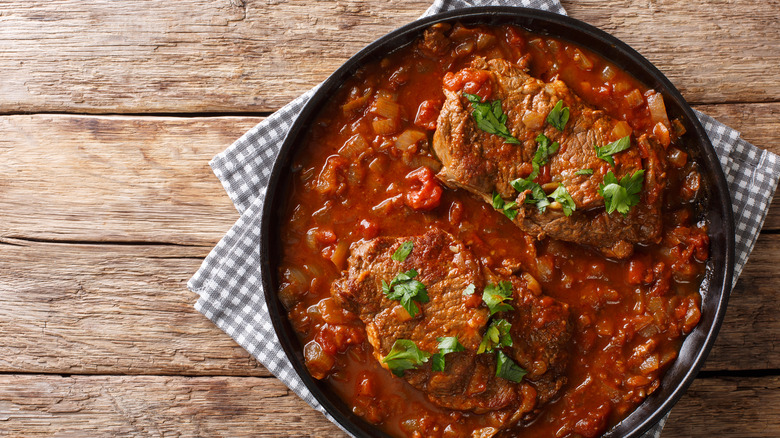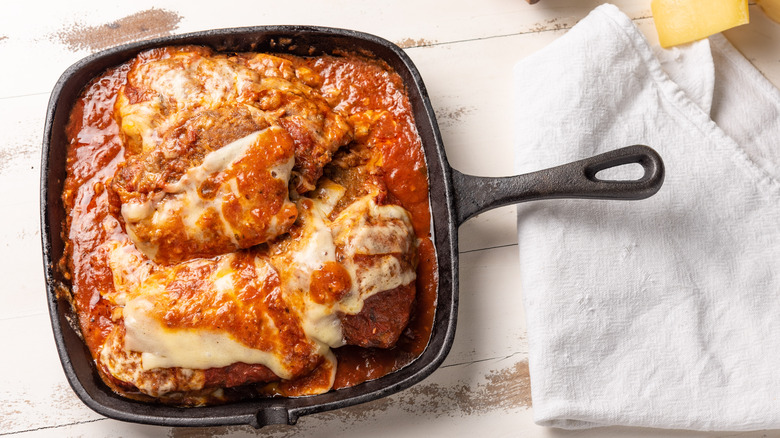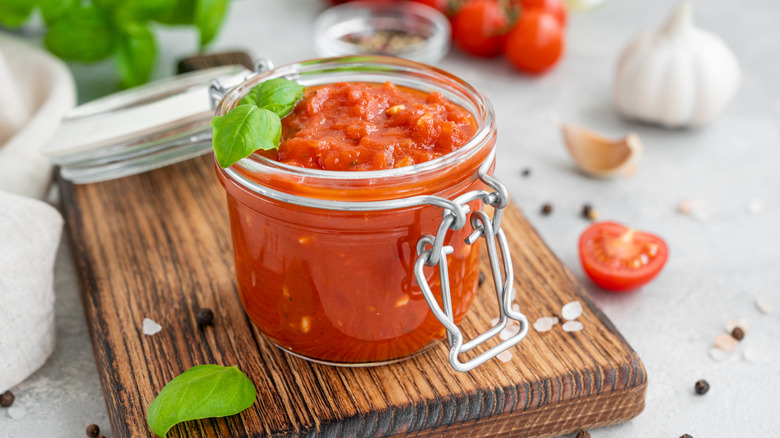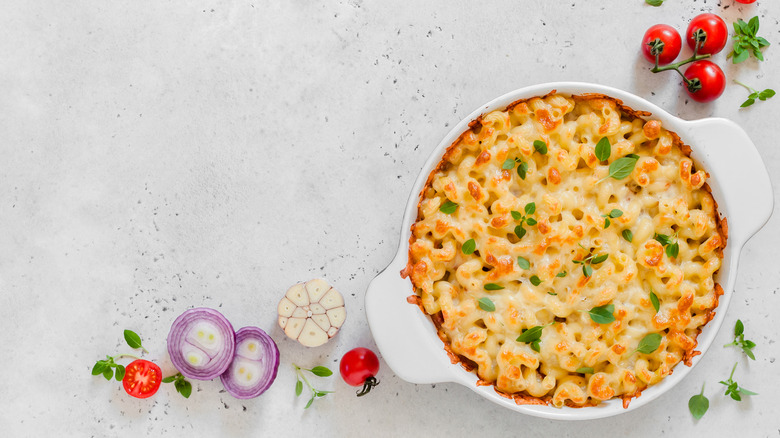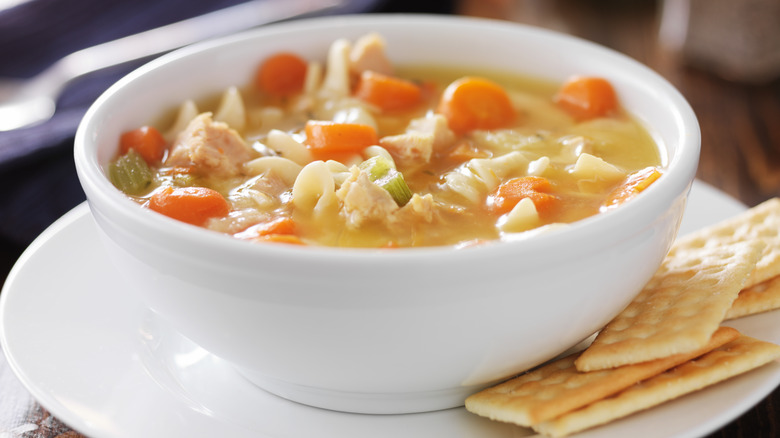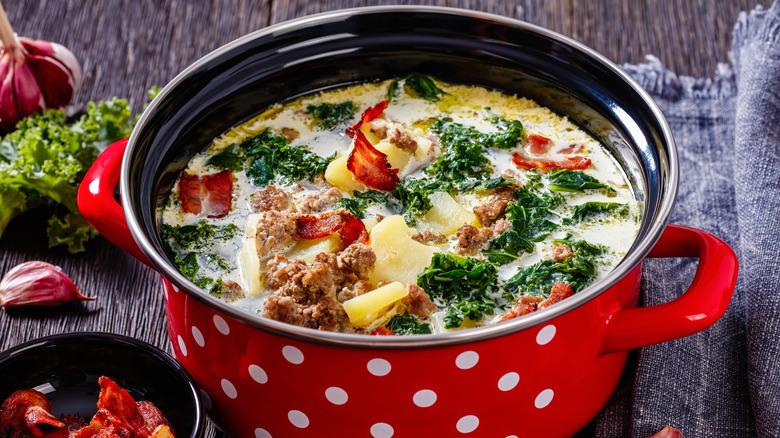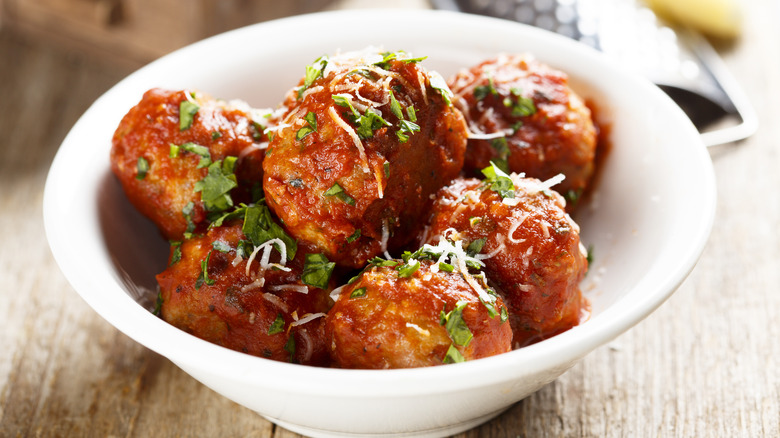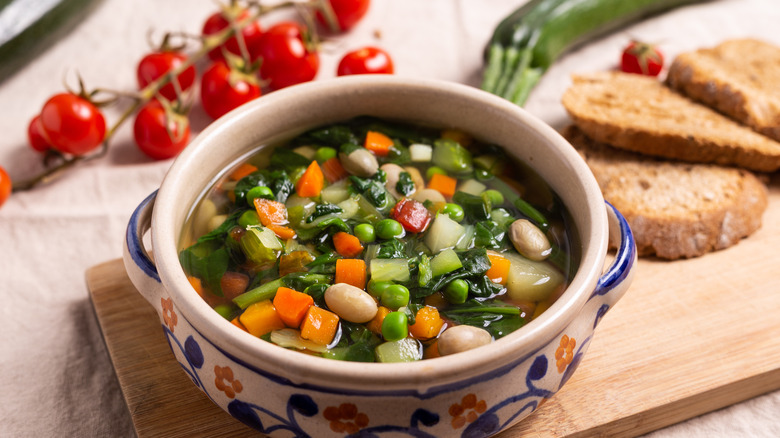The 14 Absolute Best Ways To Use Italian Seasoning
Italian seasoning is an herb mix that captures the essence of Italian cooking. It's a blend of dried herbs with an earthy and peppery aroma that best fits Italian dishes but can become part of many other foods, lending that unmistakable flavor to them. There are several herbs in Italian seasoning; the representative ones are oregano, basil, thyme, rosemary, and marjoram.
You can choose to buy a pre-made Italian seasoning version, or you can make your own. A version of the classic Italian seasoning recipe that is very easy to make replaces marjoram with parsley. Still, it allows you to add it alongside other herbs with the same flavor profile. Although some store-bought versions of Italian seasoning include garlic powder or onion powder, these are not specific to the Italian flavor palate and tend to clump at the bottom of the jar, so it's best you avoid them. So, if you like the earthy-peppery aroma of Italian foods, try using Italian seasoning in one of the following dishes.
Add it to pizza sauce
Pizza sauce is one of those ingredients we usually take for granted, as it's always present on pizzas and its flavors blend so well with the toppings that we often fail to acknowledge them. Nevertheless, pizza sauce offers a mixture of tastes, from the sweetness and acidity of tomatoes to the slight sting of garlic and the wonderful earthiness of the herbs. In addition, the complex, layered aroma makes pizza a staple food, something you will always return to when searching for something easy and tasty.
Although you can buy pre-made pizza sauce, preparing your own gives you a chance to play around with texture and flavor, and, aside from the toppings, gives your pizza recipes their uniqueness. For example, this easy pizza sauce recipe uses tomato paste, tomato sauce, and a generous amount of Italian seasoning combined with salt and pepper. Cooking the Italian seasoning with the two types of tomatoes allows the herbs to release their flavors. These become more robust through boiling and complement the tomatoes nicely. The pizza sauce can be used on several dishes, from pizza to English muffins and sandwiches.
Make a lasagna
Lasagna is a well-known and loved Italian-American dish with a complex history and diverse origins. Believed to have been inspired by several Greek and Roman recipes, lasagna as we know it today was introduced by Francesco Zambrini from Bologna in the 1880s, (via Italy Magazine). The Bolognese version makes lasagna with green pasta dough containing spinach. Although most recipes don't use spinach, the rest of the main ingredients remain the same: layers of pasta dough, ragù sauce, béchamel, and Parmigiano-Reggiano cheese on top. As such, the dish is a happy combination of acidic, well-flavored Bolognese sauce and creamy béchamel.
This classic lasagna Bolognese recipe combines all the flavors of the traditional recipe, using fresh ingredients that will grant stronger flavors to your dish. The Bolognese in the recipe is made with fresh celery, carrots, onions, minced beef and pork, and chopped tomatoes, then flavored with Italian seasoning, bay leaves, basil, red wine, and Worcester sauce. This explosion of aromas stands against the creamy and buttery béchamel. After the lasagna is layered and cooked, you will get the two contrasting sauces, completed by the soft pasta and melted Parmesan and mozzarella. What's not to like in this assortment of tastes and textures?
Try a chicken ribollita soup
Ribollita is a Tuscan bread soup recipe with a history-steeped preparation method. It belongs to the humble tradition of Italian cooking, with recipes dating from the Middle Ages that use whichever ingredients are available and are great for repurposing different foods, notes Italy Magazine. Ribollita (translated as re-boiled) originated in the Middle Ages when the simple people who served at the noblemen's feasts would take the leftover crusts and crumbs of bread. These would be soaked in various meat juices and sauces for flavor and added to a vegetable soup that used the sauce-soaked bread as a base. As the name states, ribollita was meant to be eaten for several days, with the bread acting like a thickening agent. The vegetables in traditional ribollita are typical in the Tuscan countryside, with beans, carrots, onions, tomatoes, and greens.
This reinterpreted ribollita recipe replaces the sauce-soaked bread with shredded chicken for a gluten-free and full-protein version. The soup is made using a slow cooker. It mixes vegetables, such as onion, celery, carrot, garlic, cannellini beans, and tomatoes, with Italian seasoning, bay leaves, chili flakes, and cooked shredded chicken. It offers a great aroma and a creamy and hearty texture, and it's great on a cold autumn day, topped with grated Parmesan.
Flavor your chicken pasta salad
Although Italian seasoning is usually paired with Italian-American dishes, that doesn't mean it doesn't go well with other foods. The combination of herbs is so tasty and versatile that it has the instant power to make almost any dish better, no matter how simple. That's why Italian seasoning pairs perfectly with a summer pasta salad. A barbecue staple dish, pasta salad is often overlooked in favor of burgers or hot dogs. But a good spread of barbecue foods includes a pasta salad, which brings together crunchy, fresh veggies and creamy pasta.
In this chicken pasta salad recipe, the Italian seasoning makes a great team with the pasta and the chicken. The dish's flavors are primarily included in the sauce, which contains mayo, olive oil, lemon juice, honey, Dijon mustard, Italian seasoning, and salt. The ingredients translate into a refreshing and creamy flavor, which works well with boiled fusilli, cooked chicken, tomatoes, lettuce, cucumber, and bell pepper. To top it off, garnish it with some fresh basil, which will also round up the flavor.
Put some zing in garlic bread
Garlic bread is the go-to side dish to accompany spaghetti or other Italian foods. It originates from Italy, and the preparation process resembles preparing bruschetta. There are several garlic bread varieties, such as crispy, soft, and herbed. Crispy garlic bread is baked whole, buttered with a spread made with butter, minced garlic, and parsley, and sprinkled with Parmesan cheese that melts when broiled. Soft garlic bread is cut in half, buttered with the same spread, covered with the other half, and heated in the oven, wrapped in aluminum foil. Herbed garlic bread adds herbs to the butter spread and is cooked the same way as crispy garlic bread.
This seared garlic bread technique proves that you don't need an oven to make garlic bread. After cutting the crust of the bread, the loaf is cut into rectangular chunks and slathered with a mix of butter, minced garlic, parsley, Italian seasoning, and salt. Then, the buttered bread is seared in a pan until crispy, resulting in garlic bread with a more robust flavor, as searing enhances the taste. Also, the crust you get when searing in a pan is crisper than the crust you would get when baking in the oven, no matter how much Parmesan you sprinkle on top. The Italian seasoning mixed with the butter will add to the flavor's complexity, taking it beyond mere garlic and parsley.
Upgrade your tomato soup
Next time you find yourself craving the comfortable delight of a good tomato soup that recalls childhood memories, don't rely on the store-bought kind, as it's often bland and lacks flavor. Instead, prepare your own tomato soup using this creamy tomato tortellini recipe and upgrade it with all sorts of ingredients and aromas. Among these is Italian seasoning, which works perfectly with the sweetness and acidity of tomatoes and brings a certain depth to the soup's taste.
Alongside the usual flavors in Italian seasoning, you will use bay leaves, red pepper, garlic, and onion for flavoring. Start by sautéing the onion and garlic, then add diced tomatoes, bay leaves, Italian seasoning, crushed red pepper, tomato puree, and tomato paste. Finally, add cream, tortellini, Parmesan, and spinach leaves when the ingredients are cooked. Thanks to the tortellini, you will have a creamy, gooey, cheesy tomato soup full of great flavors and a wonderful surprise texture.
Flavor a Swiss steak
Swiss steak is a type of butcher's cut and a method of slow-cooking beef. The long cooking time and technique guarantee that the meat softens, so it's mainly used for relatively tough cuts. Swiss steak can be done on the stovetop and in the oven. Essentially, the dish's name refers to the process of tenderizing the meat. Making Swiss steak starts with braising the vegetables, then the meat, and then covering both in pureed tomatoes and simmering for almost two hours.
This easy Swiss steak recipe uses round steak, onion, celery, garlic, tomato paste, canned tomatoes, Italian seasoning, and Worcester sauce. First, coat the seasoned beef with flour, then sear it. Then, cook the thinly sliced onions, celery, and garlic. Cover the veggies and the meat with tomato sauce, chopped tomatoes, some beef broth, and Worcester sauce, and add the Italian seasoning. Then, cook the meat and vegetables for two hours. You will have a thick sauce full of flavor and tender meat. Swiss steak goes well with steamed potatoes, green beans, and carrots.
Add it to chicken parmesan
Chicken parm, short for chicken Parmesan or chicken Parmigiana, is a dish with an exciting history deeply intertwined with the culture of the Italian-American community. However, chicken parm is absent in Italy, notes the Los Angeles Times, although it is considered an Italian staple. Instead, you will find melanzana alla Parmigiana, a dish made with eggplant, tomato sauce, and cheese, on the menu of many restaurants. We can only speculate about why the eggplant was replaced with chicken in Italian-American cooking, but one thing is sure: Chicken parmigiana has become a representative food in America.
This chicken Parmesan recipe shows you a simple way of preparing this representative food, which doesn't have to be a burden in the kitchen. The main ingredients are the classic ones: chicken breast, bread crumbs, Parmesan cheese, flour, Italian seasoning, eggs, tomato sauce, and mozzarella cheese. The dish's rich flavors result from the combination of Italian seasoning, tomatoes, mozzarella, and Parmesan. First, bread the chicken using flour, eggs, and bread crumbs. Then, bake the chicken until the breadcrumbs turn golden brown. Finally, coat the chicken in sauce and cheese and bake it again until it melts. Chicken parm is best paired with pasta, and it also goes well with a salad.
Round up your marinara sauce
Marinara sauce is a versatile tomato-based dish used as a dipping sauce that differs from spaghetti sauce as it has no meat. Marinara can be used alongside cheese breadsticks, chicken parm, manicotti, or other dishes. Its main ingredients are canned tomatoes, onions, seasoning, and herbs for flavoring. The flavoring part is where imagination comes into play, as every recipe has its own perspective. However, some flavors work perfectly with the acidity of tomatoes, while others don't. The herbs included in Italian seasoning are all perfect to pair with tomatoes because their peppery and earthy qualities re-define the tomato's sweetness.
Some marinara recipes use just a few of the herbs in Italian seasoning. For example, this easy marinara sauce recipe uses thyme, oregano, and basil, while this fast marinara sauce recipe only uses basil. Using all the diverse flavors of Italian seasoning for your homemade marinara sauce instead of just one herb is recommended when you have the pre-packed seasoning on hand and want to add a bit more flavor. Just think of the herby kick you will get when adding oregano, basil, rosemary, thyme, and marjoram to your next marinara sauce.
Make a pasta bake
The ultimate cheesy, gooey comfort food for cold months is the pasta bake, a casserole full of brown bubbling cheese, pasta, and a meaty, aromatic sauce. It is a staple of home cooking, and variations of the recipe abound. However, as most pasta bakes contain some variety of tomato sauce, it's clear that you can't go wrong with using Italian seasoning for flavoring.
One of the essential ingredients to consider when making a pasta bake is the pasta itself. Plenty of pasta varieties are suited for casseroles, such as farfalle bow ties, fettuccine, fusilli, and ziti. You must ensure that you coat the pasta in enough sauce; otherwise, it will dry while baking. This baked ziti recipe uses ziti pasta, sweet Italian sausage, onion, garlic, tomato paste, dry red wine, and tomato sauce. The seasoning is made with three herbs, oregano, thyme, and basil, which can easily be upgraded to Italian seasoning. Adding rosemary and marjoram to the herby flavor mix works well with the Italian sausage, the tomato paste and sauce, and the red wine. Italian seasoning is a welcome addition and a flavor enhancer in this recipe.
Add it to chicken noodle soup
Chicken noodle soup is considered to be one of the most comforting dishes and is almost always associated with recovering from a cold. The warm feeling it brings and the sweet, delicious taste become the perfect comfort for anyone sick with the flu. The traditional flavoring herbs used for chicken noodle soup are thyme, bay leaves, and parsley. However, as basil and rosemary work very well with these flavors, Italian seasoning is another way to go.
This easy chicken noodle soup recipe uses extra-virgin olive oil, onions, carrots, celery, seasonings, chicken broth, egg noodles, rotisserie chicken, and chopped parsley. You can add other veggies, such as zucchini, corn, and dark leafy greens. The soup needs only one pot to cook. Start by sautéing the chopped veggies, add the herbs, salt, and pepper, pour the broth and bring the soup to a boil. Toss in the noodles and cook them, then add the chicken and parsley. You will have the ultimate warming soup with just a touch of peppery earthiness from the herbs.
Make a zuppa Toscana
Much like the chicken ribolitta, zuppa Toscana is a thick Tuscan-inspired soup. However, unlike ribolitta, zuppa Toscana is made with sausage and potatoes. It is a well-appreciated dish in Italian-American restaurants in the U.S. and you'll often see it on the menu. Its staple ingredients are heavy cream, potatoes, kale, and sausage. The soup also boasts the contrasting flavors and textures of bacon, shallot, garlic, and Parmesan. It's a symphony of different tastes, which come together under the sign of Italian flavors.
Italian flavoring is also why the dried rosemary in zuppa Toscana can be upgraded to the full version of Italian seasoning, which includes more flavors. In this zuppa Toscana recipe, the versatility of the ingredients allows for several swaps, such as adding carrots or a can of beans or using only some of the veggies. The Italian seasoning brings a nice touch to the browned Italian sausage and bacon, adding layers to the aroma. To make the zuppa Toscana, crisp the bacon, brown the sausage, cook the shallot and garlic, and add the white wine, potatoes, and chicken broth. Next, add the sausage, bacon, and seasoning, and drop the greens when the potatoes are soft. Top with heavy cream or milk and serve with freshly grated Parmesan.
Serve some Italian meatballs
Italian meatballs are a delicious Italian-American dish, and you most likely tried them at least once and indulged in a plate of spaghetti and meatballs. It's another comfort food reminiscent of family lunches and good times. The sweet tomato sauce, the flavors of the herbs, and the creamy and aromatic Parmesan all come together to make a truly satisfying dish. And although the traditional recipe of Italian meatballs requires herbs such as oregano, parsley, and basil, you can try adding more layers of flavor and using Italian seasoning. It works wonderfully with the Parmesan in the recipe and brings a certain complexity to the dish.
This classic Italian meatballs recipe with homemade tomato sauce showcases the dish at its finest. The meatballs are soft due to the combination of ingredients and the presence of milk-soaked breadcrumbs, and the sauce has a rich flavor, as it starts with fraying pancetta. Mix the breadcrumbs with milk, add the meat, garlic, onion, Italian seasoning, salt, pepper, Parmesan cheese, and egg yolk and then shape the meatballs. After you cook them in the oven, prepare the tomato sauce. First, brown the pancetta, then add onions, garlic, red wine, and San Marzano tomatoes. Next, add the cooked meatballs to the sauce and simmer them so that they are soaked in the sauce. You can serve the meatballs over pasta, on their own, or in a meatball sandwich.
Enjoy a minestrone soup
Minestrone is a traditional Italian soup with all sorts of vegetables and sometimes pasta. It has a thick, stew-like consistency and a flavorful broth and is packed with healthy ingredients, allowing several veggie combinations. Some core ingredients include celery, onions, garlic, carrots, tomatoes, olive oil, and pasta, but you can add whatever you want (provided that tastes don't clash). Also, minestrone uses lots of Italian-specific herbs for seasoning, such as basil, oregano, and thyme. Therefore, upgrading these and using Italian seasoning can be only fitting.
If you want to prepare a hearty minestrone soup recipe, use onion, garlic, carrots, celery, oil, russet potatoes, canned tomatoes, small pasta, vegetable broth, pesto, Italian seasoning, salt and pepper, white beans, and spinach. Swap any veggies according to what's in season or your preferences, as minestrone is a versatile dish. Start by cooking the veggies, then add the potatoes, tomatoes, seasonings, pesto, broth, and water. When the veggies are soft, add the beans and spinach, as they need less time to cook, and once the spinach wilts, remove the soup from the heat. Finally, serve the soup with bread or breadsticks, as the broth is excellent for dunking breadsticks.

